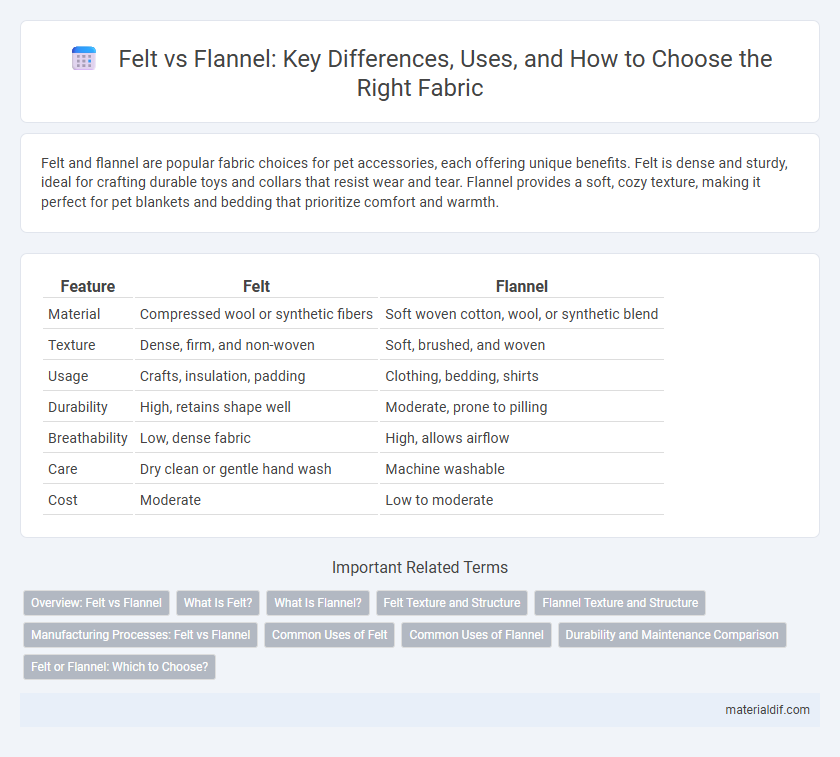Felt and flannel are popular fabric choices for pet accessories, each offering unique benefits. Felt is dense and sturdy, ideal for crafting durable toys and collars that resist wear and tear. Flannel provides a soft, cozy texture, making it perfect for pet blankets and bedding that prioritize comfort and warmth.
Table of Comparison
| Feature | Felt | Flannel |
|---|---|---|
| Material | Compressed wool or synthetic fibers | Soft woven cotton, wool, or synthetic blend |
| Texture | Dense, firm, and non-woven | Soft, brushed, and woven |
| Usage | Crafts, insulation, padding | Clothing, bedding, shirts |
| Durability | High, retains shape well | Moderate, prone to pilling |
| Breathability | Low, dense fabric | High, allows airflow |
| Care | Dry clean or gentle hand wash | Machine washable |
| Cost | Moderate | Low to moderate |
Overview: Felt vs Flannel
Felt is a non-woven fabric made by compressing and matting fibers together, resulting in a dense, sturdy material often used for crafts and insulation. Flannel, on the other hand, is a woven fabric typically made from cotton, wool, or synthetic fibers, known for its soft texture and warmth, making it popular for clothing and bedding. While felt offers rigidity and thickness, flannel provides breathability and comfort, highlighting their distinct applications in textiles.
What Is Felt?
Felt is a non-woven textile produced by matting, condensing, and pressing fibers together, typically made from wool or synthetic materials. Unlike flannel, which is a woven fabric featuring a soft, napped surface, felt is dense and firm with no visible weave or grain. Its unique structure provides excellent insulation, cushioning, and durability, making it ideal for crafts, upholstery, and industrial applications.
What Is Flannel?
Flannel is a soft woven fabric typically made from cotton, wool, or synthetic fibers, known for its warmth and cozy texture due to its slightly napped surface. It is commonly used in cold-weather clothing such as shirts, pajamas, and bedding because it provides excellent insulation and breathability. Unlike felt, which is non-woven and created by matting fibers together, flannel's woven structure allows for greater flexibility and durability.
Felt Texture and Structure
Felt features a dense, matted texture formed by compressing and matting fibers together without weaving, resulting in a sturdy, non-fraying fabric ideal for crafts and insulation. Flannel exhibits a soft, brushed texture with a twill or plain weave structure, providing a warm, smooth surface commonly used for clothing and bedding. The compact, interlocked nature of felt contrasts with flannel's flexible, woven construction, affecting durability and tactile experience.
Flannel Texture and Structure
Flannel features a soft, napped finish created by brushing the fabric, enhancing its warmth and comfort, which distinguishes it from felt's dense, non-woven structure. Its loosely woven cotton or wool fibers create a breathable yet insulating texture, making flannel ideal for cozy apparel and bedding. The tactile surface of flannel provides a distinct fuzzy feel and visible weave, unlike felt's smooth, solid consistency.
Manufacturing Processes: Felt vs Flannel
Felt is produced by matting, condensing, and pressing fibers together through heat, moisture, and agitation, eliminating the need for weaving or knitting, which results in a dense, non-woven fabric. Flannel is manufactured by weaving wool, cotton, or synthetic fibers into a twill or plain weave and then napping the surface to create a soft, brushed texture. The non-woven process of felt provides thickness and stiffness, while flannel's woven structure allows for flexibility and softness.
Common Uses of Felt
Felt is widely used in crafts, insulation, and padding due to its dense, non-woven structure that provides excellent cushioning and sound absorption. It is commonly utilized for making hats, toys, and decorative items, as well as in industrial applications like gaskets and filters. Unlike flannel, which is soft and brushed for comfort in clothing and bedding, felt offers durability and firmness ideal for protective and structural purposes.
Common Uses of Flannel
Flannel is commonly used in the production of cozy clothing items such as shirts, pajamas, and blankets due to its soft texture and warmth. The fabric's breathable qualities make it popular for casual wear and bedding, providing comfort in cooler weather. Flannel's ability to retain heat while remaining lightweight makes it ideal for layering garments and home textiles.
Durability and Maintenance Comparison
Felt, made from densely matted fibers, offers superior durability and resistance to wear, making it ideal for heavy-duty applications. Flannel, composed of woven cotton or wool with a soft, napped surface, requires more careful maintenance to prevent pilling and shrinkage. While felt withstands frequent use and harsh conditions with minimal care, flannel benefits from gentle washing and air drying to maintain its texture and longevity.
Felt or Flannel: Which to Choose?
Felt offers dense, non-woven fibers ideal for crafts requiring sturdy, moldable material, while flannel provides a soft, woven texture perfect for cozy clothing and bedding. Felt is typically made from wool or synthetic fibers pressed together, creating a durable fabric resistant to fraying, whereas flannel is brushed cotton or wool fabric with a warm, fuzzy surface. Choosing between felt and flannel depends on the desired use: select felt for structural projects and flannel for comfort-focused textiles.
felt vs flannel Infographic

 materialdif.com
materialdif.com